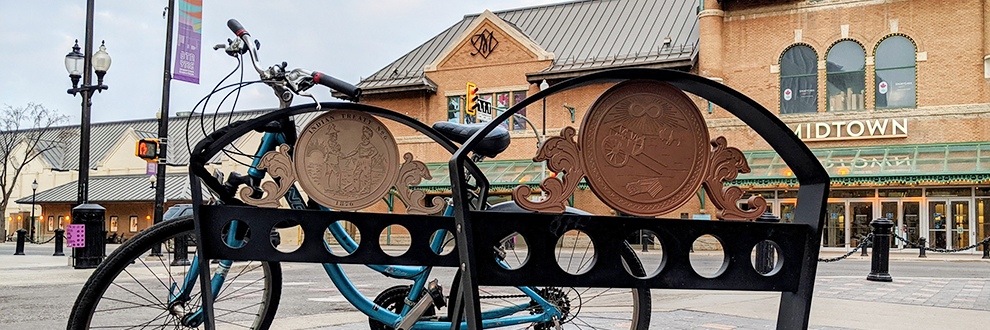Treaty 6 & Métis Homeland

Saskatoon is located on Treaty 6 Territory and the Homeland of the Métis. As a way to honour First Nations and Métis peoples' histories and cultures, the City of Saskatoon worked together with local Elders, Harry Lafond and Senator Nora Cummings, to feature Treaty 6 Territory and Homeland of the Métis medals on bike racks along Saskatoon's historical 21st Street. The Saskatchewan Indigenous Cultural Centre (SICC) and the Gabriel Dumont Institute (GDI) provided important historical information to explain the significance of the medals and the history of First Nations and Métis peoples in Saskatoon and surrounding area. With the support of the Downtown Business Improvement District, this information is posted in the directories along 21st Street.
The Treaty No. 6 Medal is representative of the relationship the Crown has with First Nations. The Cree, Nakoda and Saulteaux leaders who signed Treaty No. 6 in 1876 in Fort Carlton were determined to ensure their peoples would continue as distinct, flourishing nations. Treaty No. 6 was part of a series of 11 numbered treaties negotiated after Confederation. First Nations people have great respect for the Treaty No. 6 Medal because it is a testament to the foresight and wisdom of our ancestors during the treaty negotiations.
The relationship represented by the Treaty No. 6 Medal is emblematic of mutual respect, balance and reciprocity. It is an evolving relationship that has at times failed with tragic consequences. As we move into the future, we must continue to improve that relationship. The treaty relationship is truly between all peoples of Canada and not just First Nations. First Nations deep appreciation of Mother Earth, respect for other traditions, the need to live together in harmony, and the interconnectedness of life contribute to a better way of life for all.
For more information, visit the History of First Nations and Saskatoon webpage.
The Homeland of the Métis Medal is representative of the history of the Métis in Saskatoon and surrounding area. During the 1850s, the Métis hunted bison in present-day Saskatoon, which they called “Bois de flèche” or Arrow Woods. Here, Métis men, such as Gabriel Dumont, wore Métis sashes while hunting bison, leaving a gauntlet by their kills while their women kinfolk processed the animals before putting the meat and hides in Red River carts. By the 1870s, Saskatoon was part of a larger Métis community which stretched from St. Louis in the north to the Round Prairie Settlement, near Dundurn, in the south. The Métis had riverlots in the region, but the Temperance Society conspired with the federal government to take this land away from them in the early 1880s. Before it was incorporated as a city, Saskatoon had a significant Métis presence, including various Road Allowance communities, which existed well into the 1950s. Today, Saskatoon is home to a large vibrant Métis community of over 15,000 people.
For more information, visit the History of the Métis in Saskatoon webpage or view the below video.
Learn more about the 21st St bike racks featuring Treaty 6 and Homeland of the Métis medals. This initiative was a response to TRC Call to Action No. 79: to commemorate the contributions and history of Indigenous peoples.


